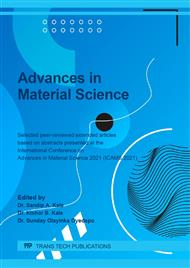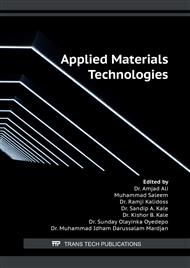p.3
p.17
p.27
p.33
p.39
p.45
p.53
p.61
Fatigue Life Estimation of 7020 Aluminum Alloy Subjected to Aqueous Sodium Chloride Solution
Abstract:
The 7020-aluminum alloy is a lightweight and high strength material which is widely used in aerospace industries where the damage tolerance, the factor of safety and environmental induced fatigue is very high. The low density and better mechanical properties enable its applications in industries over conventional engineering materials. In the present work, the fatigue crack growth (FCG) behavior of the pre-corroded 7020-aluminum alloy was investigated. The samples were subjected to an aqueous solution of sodium chloride; the micro-hardness was optimized and the significance of corrosion on FCG was studied in the context of bending stress, the number of cycles (N) to failure/fatigue life and microstructure. The solution treated samples at a temperature of 520°C for 3 hours provided the maximum hardness. However, the hardness of samples was optimum for 3 hours of solution heat treatment and minimum for 2 hours of solution heat treatment. It is suggested that the precipitation of the metastable phase affected the hardness. In the initial stage, the fatigue life of pre-corroded samples was significantly lower as compared to as-received samples. However, at the later stage, it became less significant but still, the pre-corroded sample showed lower fatigue life. Both types (pre-corroded and as-received) of samples showed a similar trend as fatigue life decreases with increasing bending stress. The fractured microstructure of the pre-corroded sample showed scratches on the surface which were produced during mechanical rubbing of the specimen pieces during plastic deformation under load. However, the microstructure at the edge of the notch showed "volcano-mouth" features" which indicated the phenomena of galvanic corrosion. The galvanic corrosion envisages due to deposition on the 7020-aluminum alloy and the impurities in the alloy. The elements Fe, Si, C and Mn existed as impurities that induced the galvanic corrosion and an elliptical corrosion pit was observed.
Info:
Periodical:
Pages:
17-23
Citation:
Online since:
August 2022
Authors:
Keywords:
Price:
Сopyright:
© 2022 Trans Tech Publications Ltd. All Rights Reserved
Share:
Citation:



